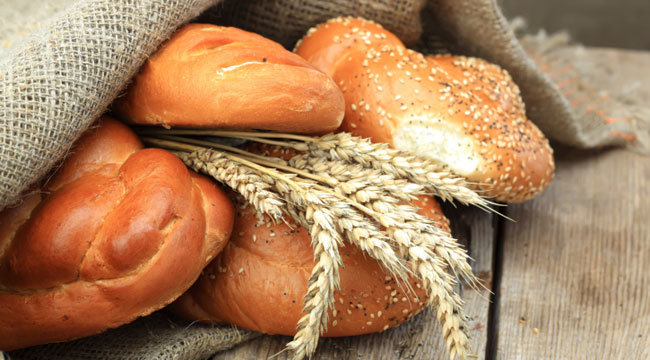28-Days-to-Lean Meal Plan
With the right plan and the right discipline, you can get seriously shredded in just 28 days.
Read article
Arnold once likened white bread to white death, and bodybuilders ever since have had a love-hate relationship with the staff of life. With the renewed popularity of low-carb diets these days, bread’s getting battered on another front, but do we really need to avoid it?
“Bread’s main function is as a source of carbohydrates for fuel,” says sports nutritionist Nancy Clark, MS, RD, author of the new third edition of Nancy Clark‘s Sports Nutrition Guidebook (Human Kinetics; www.hkusa.com). “Get the bulk of your other nutrients from fruits, vegetables, low-fat dairy products, and lean meat and poultry,” she advises. Even whole-wheat bread, while more nutritious than white bread, isn’t a nutrition powerhouse, she states.
How much bread should an athlete eat? Clarks points out that the U.S. Department of Agriculture recommends 6-11 servings of bread and grain products a day. The 11 servings correspond with the 2,800-calorie active man’s diet.
But watch what you put on that bread, Clark warns. “If you’re trying to lose weight, skip the butter, not the bread,” she says.
You don’t need to eat half a loaf of bread to meet your quota. Cereals, rice, crackers, pasta and other grains are part of this food group. Oatmeal, the bodybuilding staple, is one such grain.
Dark breads offer more nutritional value — if they’re whole-grain, not just white bread with coloring added. Ideally, the optimal sports diet would have more whole-grain than refined-flour products. That’s because refining removes nutrients and fiber, and enriching replaces only four of the lost vitamins, plus iron. Look for the term “100% whole wheat” or other whole grains at the beginning of the ingredients list. Some breads may have only a little whole wheat, bran or oatmeal added, which may not make much difference nutritionally.
Yet Clark notes: “Every slice of bread you eat doesn’t have to be 100% whole-wheat. Delicious multigrain breads are available. And even if you eat some white bread, you won’t be eating ‘poison.’ You can balance it into the whole diet.”
Look for fiber listings, too. Aim for breads that provide 2 or more grams of fiber per slice. Besides whole-wheat, rye, pumpernickel, bran and multigrain varieties may have higher fiber levels.
Diet breads or light breads have fewer calories and carbs per slice. They’re generally smaller slices, with more air or fiber added. This might be worthwhile for someone on a tight carb budget, but the hard-training bodybuilder needs carbs throughout the day. “Too few carbs at breakfast and lunch can leave an athlete or dieter famished and bingeing on sweets in the evening,” Clark says.
Denser and heavier bread products can have the opposite effect, providing more carbs and calories than you realize. Bagels are notorious for being larger than that model bagel in some nutrition charts. Pizza crust can be a stealthy source of extra carbs and calories, especially the thick kind. If you’ve ever made pizza using bread dough, you know one crust can equal one loaf of bread. So choose your portions accordingly.

With very-low-carbohydrate diets regaining favor nowadays, some bodyfat-conscious bodybuilders might be tempted to slash their carbs. “I suggest to athletes that they do an experiment,” says Clark. “For one week, limit the carbs and see what happens. You’ll probably notice you have less energy and train poorly. The next week, have carbs at each meal, a tuna sandwich instead of just tuna, for example. You’ll see the benefit to having carbs.
“You’ll feel better and perform better with the carbs,” she explains. “You may weigh more because each ounce of stored carbohydrate in the form of glycogen holds 3 ounces of water.”
Clark adds: “Some bodybuilders are in the gym 1-2 two hours a day. When you exercise that much, you’re certainly doing endurance-level exercise, and getting adequate carbohydrates is important to being able to perform.” Bread is an easy, economical and tasty way to get those carbs.
A sampling of different types of bread. Sizes of slices vary greatly, so always check labels for specific nutrition data.
| Type | Size (g) | Calories (g) | Protein (g) | Carbohydrate (g) | Fat (g) | Fiber (g) |
| White | 25 | 67 | 2 | 13 | 1 | less than 1 |
| Wheat | 25 | 65 | 2 | 12 | 1 | 1 |
| Whole-wheat | 28 | 69 | 3 | 13 | 1 | 2 |
| Mixed-grain | 32 | 80 | 3 | 15 | 1 | 2 |
| Rye | 32 | 83 | 3 | 15 | 1 | 2 |
| Reduced-calorie white | 23 | 48 | 2 | 10 | < 1 | 2 |
Source: USDA database. Numbers are rounded.
Notifications